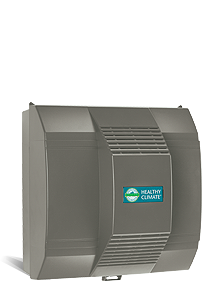April 25, 2013
When the air in your home is clean, your family breathes and feels better. 
When the air in your home is clean, your family breathes and feels better. If you or a family member suffers from allergies, it may be things floating around your house that are causing them. In addition to the particles and chemicals, high humidity levels can cause mold which could be contributing to your indoor allergies. There are steps you can take to help make your home allergy-free.
Asthma isn’t a joke for people who suffer from the condition. It’s scary when the attacks hit, and they can greatly affect how you live life, including being dangerous for people with severe asthma. That’s why it’s so important to do whatever you can to reduce the triggers in your home. Discover the relationship between clean air and reducing asthma triggers for you or your loved one.
Understanding Asthma
Asthma is an inflammatory condition that constricts the bronchial tubes. During an asthma attack, the bronchial tubes swell and become narrow, reducing the amount of air that comes through. Part of the restriction comes from the production of excess mucus that lingers in the bronchial tubes, further restricting the airflow to the lungs.
Asthma is often linked to an allergic reaction, which is why it produces mucus. That’s why so many of the things that cause traditional seasonal allergies also trigger asthma attacks. However, it can also be other allergies, like contact or food allergies.
Unfortunately, for many people who suffer from this condition, it’s not as simple as taking an antihistamine like you would for common allergic reactions. Rather, it often requires the combined use of a controller inhaler with a rescue inhaler. This is why it’s so important to reduce exposure to triggers for you or your loved one, especially in your home.
Signs of Poor Indoor Air Quality
There are several things to look for when trying to detect poor indoor air quality. Are there musty odors in your home? Is the wood in your home warping or is the paint peeling or chipping? Are the walls and ceiling discolored? Can you breathe more easily when you leave your home?
If the answer to one or more of these questions is yes, then you may have some issues that you need to address. While cleaning and other maintenance to your home may help improve these conditions, more action may be required to actually help reduce your allergy symptoms.
Keep Humidity in Check
High humidity levels can contribute to indoor air quality problems. Too much humidity in your home causes mold and mildew to grow due to too much moisture in the air. It is suggested to keep humidity levels under 50% and the temperature set at 70 degrees. Living in Missouri can make this difficult to control.
The average yearly humidity level in Missouri is 70%. It is generally higher in the morning and lower in the evening. If this is the cause of your allergy problems, you may need to take more aggressive measures to control this issue.
How Do Airborne Contaminants Affect Asthma?
Many asthmatic triggers are common airborne contaminants. These may include:
- Dust
- Dust mites
- Cockroaches
- Pet dander
- Rodent hair and feces
- Ozone
- Vapors
- Chemicals
These are the same things that concern HVAC professionals working to improve indoor air quality. Unfortunately, many of these contaminants come from within the home, not just from the outside environment.
One of the best ways of limiting exposure to these contaminants is by keeping a deep cleaning schedule. Even with that, you still have to deal with the contaminants floating in the air before they settle somewhere in your house.
That’s where using the proper combination of indoor air quality devices is so important. Not all air quality devices do the same thing. Rather, there’s a big difference in the various technologies available, and some could actually trigger that asthma response. Dig further to discover which devices are the best for people who suffer from asthma.
Understanding Air Filters and Air Purifiers
The first thing most people think about when it comes to cleaning the air in their homes is a filter. In fact, the HEPA filter is probably one of the most popular for removing most contaminants from the air.
The challenge is that filters alone don’t sanitize the air; rather, they just capture the contaminants. That means they may get picked up and recirculated into your home. It also means that when you change your filter, you may release a bunch of the contaminants back into the air.
Additionally, you may not be able to simply replace your furnace filter with more substantial options. These filters may actually choke your HVAC system, leading to reduced efficiency and more repairs.
Every air purifier includes a filtering component to help remove the contaminants from the air. But not all air filters include a purification component.
When it comes to purifying the air, the common technologies used include:
- UV technology
- Negative ion
- Ozone
You want to be careful of any product that releases ozone as part of the purification process. It will irritate the respiratory tract for everyone, and it can lead to a severe asthmatic reaction.
There are three categorical types of purifiers. First, there are the small room purifiers you see on the shelf at your local hardware store. There are much larger versions of these, known as industrial portable purifiers. Then, you have the purifiers you install as part of your HVAC system. In most cases, you’ll benefit the most from one that installs as part of your HVAC system because it treats the entire house.
You may want a room purifier for anyone who has severe asthma to keep in any room where they spend a lot of time, such as a bedroom or office. The larger industrial-sized units usually aren’t needed unless you do a home renovation project that produces a lot of dust. In that case, you may want to rent one and use it for a few days to a week to help clean up the air.
Can Air Scrubbers Help?
Air scrubbers typically use either UV or negative ion technology to break down the pollutant molecules. These technologies break the chemical bonds in carbon-based compounds, reducing the particles to their more basic forms, such as carbon dioxide and water.
Some triggers include smells, which is why these scrubbers are so helpful for dealing with triggers. By breaking apart the chemical bonds, you neutralize the odors, removing the trigger through a chemical process rather than relying solely on a filter.
Some air scrubbers go a step further and release negative ions into the air. These attract particles in the air, causing them to stick together and fall due to their weight. This added component helps clean the air throughout your house, not just what’s circulating through the system.
Does Indoor Humidity Matter?
Humidity doesn’t directly typically trigger asthma as a result of the moisture. Rather, some people find the extra moisture helps relieve some symptoms. However, it’s the effects of humidity that may trigger an attack.
When your indoor humidity is too low, the contaminants in the air are lighter, staying airborne longer. It also dries out things around your home, including skin, furniture, and more. This dry environment causes additional airborne contaminants like dust. Further, a dry environment may irritate the respiratory tract, making it more susceptible to triggers.
Too much moisture is just as problematic as not enough. When the humidity is too high, it encourages biological growth throughout your residence. This leads to releasing spores into the air, further increasing the volume of trigger contaminants.
The best bet is to tightly control the humidity throughout your home. You may need to run a dehumidifier over the more humid summer months while considering a humidifier over the drier winter. According to the EPA, the ideal humidity range is 30% to 50% relative.
How Your HVAC System Affects Air Quality
Your HVAC system itself contributes to poor air quality. Neglected systems have a buildup of contaminants in the system, typically in the ducts, on the circulating fan, on the evaporator coil, and even in the burn chamber. The circulating air picks these up and circulates them back into your house.
The best solution is to ensure you schedule regular seasonal maintenance. A primary focus for your technician is cleaning these problematic areas. However, they’ll also tighten mounting hardware and electrical connections and test the system. This leaves you with a more efficient unit in addition to improved air quality.
Control Your Indoor Air Quality
Scott-Lee Heating Company can help you reduce air pollutants in your home. There are a number of air filtration and purifying solutions to choose from. An air filtration device is any device that uses a filter to capture particles in a systems air stream. An air purification system performs as an air filter, but also purifies the air in your home by using various processes. However, because too much humidity in the home can cause mold, mildew and bacteria to thrive a dehumidifier can help reduce humid conditions in the home and thus reduce the risk of these problems.
People around St. Louis have trusted Scott-Lee Heating Company to keep their indoor air comfortable and safe since 1978. Our technicians provide customized indoor air quality solutions combined with heating and cooling installation, maintenance, and repair. Contact Scott-Lee Heating today at 314- 756-9444 to find out which system is right for your home.
